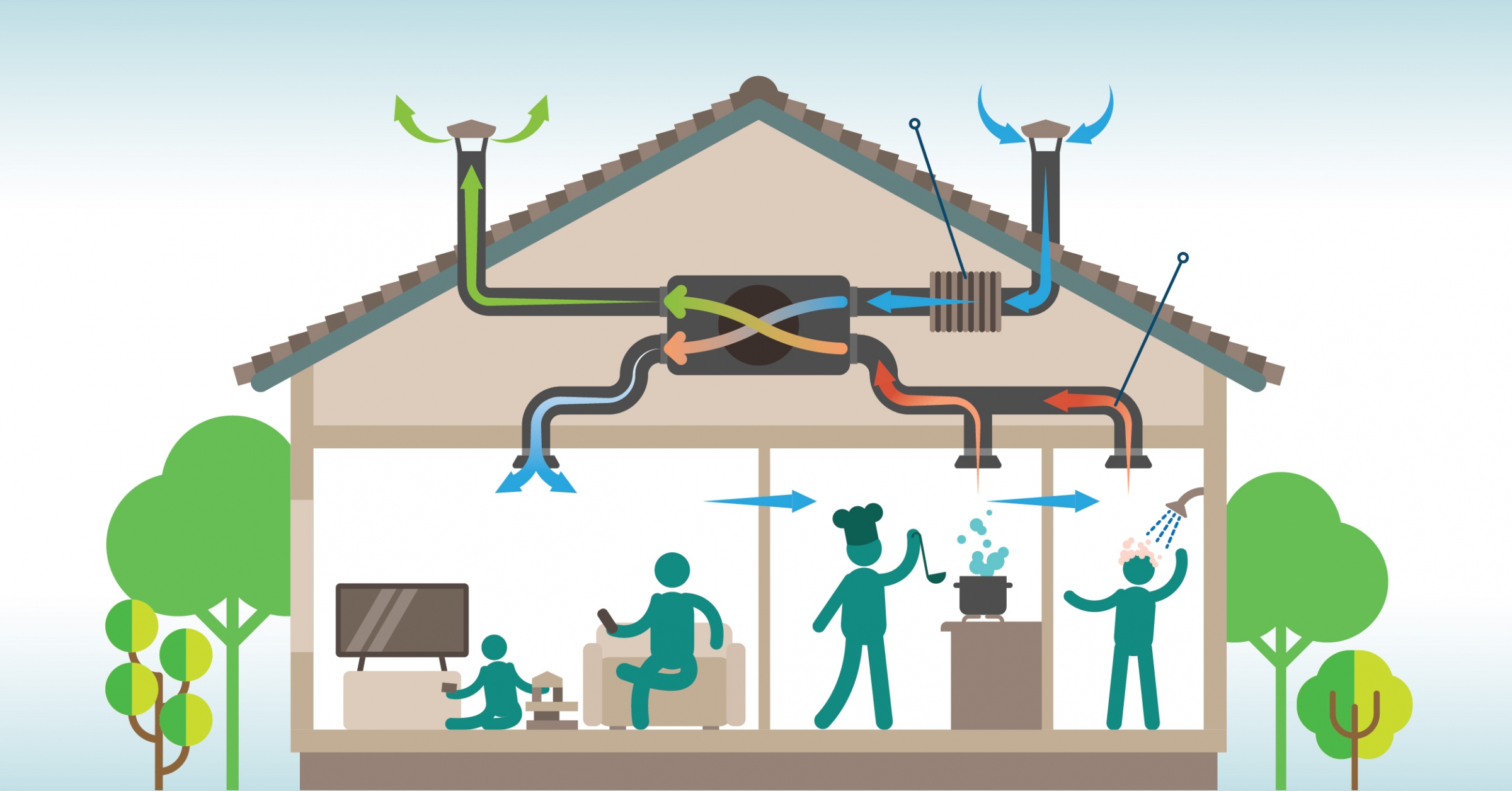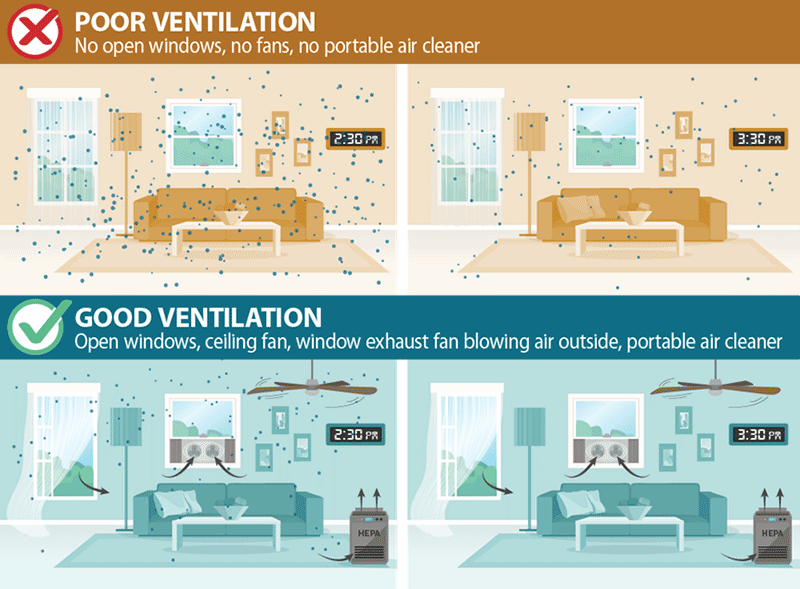Home Ventilation Melbourne Solutions for Energy-Efficient Homes
Checking Out Innovative Solutions for Ideal Home Air Flow Equipments
Home air flow plays an essential duty in preserving health and wellness and convenience within living spaces. With innovations in technology, cutting-edge options are emerging to enhance these systems. Smart air flow, power recuperation ventilators, and advanced filtering are improving just how air high quality is handled - Home Ventilation Melbourne. Nevertheless, the assimilation of these modern technologies raises inquiries concerning their efficiency and adaptability in different home environments. What effects do these developments hold for future living criteria?
The Importance of Home Ventilation for Health and Comfort
Usually overlooked, home air flow plays an important role in keeping both health and comfort within household spaces. Ample air flow is essential for the blood circulation of fresh air, which aids to thin down indoor pollutants such as volatile natural substances, irritants, and odors. Without correct air movement, these pollutants can accumulate, resulting in respiratory system issues and various other wellness issues. In addition, efficient air flow adds to regulating humidity levels, preventing mold and mildew development and structural damage. By making sure a well balanced exchange of air, locals can appreciate a much more pleasurable indoor atmosphere, enhancing overall well-being. Additionally, ample air flow can boost energy performance by lowering the need for extreme heating or cooling, inevitably causing lower utility costs and a more sustainable home.
Smart Air Flow Solutions: Harnessing Technology for Performance
Smart air flow systems represent a substantial improvement in home air management, leveraging IoT integration for boosted control. These systems not only promote energy efficiency yet additionally offer remote surveillance capabilities, allowing customers to maximize their interior environments seamlessly. By utilizing modern technology, house owners can attain better air quality while reducing energy consumption.
IoT Integration Benefits
Just how can IoT combination change traditional air flow systems right into highly reliable wise solutions? By including Web of Points (IoT) innovation, ventilation systems can achieve real-time monitoring and control, boosting their functional efficiency. Sensing units put throughout a home gather information on air temperature, moisture, and top quality, permitting for automated changes based upon current conditions. This instant responsiveness brings about enhanced interior air quality and comfort levels. In addition, IoT-enabled systems can connect with various other smart home devices, creating a natural community that maximizes power usage. Users can also accessibility and handle their air flow systems from another location by means of smartphones, giving benefit and enhanced control. Overall, IoT combination represents a considerable development, bringing intelligence and adaptability to conventional ventilation techniques.
Power Performance Includes
As power effectiveness comes to be an essential focus in modern home style, progressed ventilation systems provide cutting-edge attributes that significantly decrease power consumption. These smart ventilation systems utilize sensors to check indoor air temperature level, moisture, and high quality degrees, automatically adjusting airflow to maintain optimal problems. By using energy recuperation ventilators (ERVs), they catch and reuse power from outgoing air, lessening home heating and cooling demands. Variable speed followers even more boost effectiveness by adjusting their operation based on real-time demands, avoiding unneeded energy waste - Home Ventilation Melbourne. Furthermore, programmable timers and tenancy sensing units guarantee that ventilation operates just when necessary, adding to lower utility expenses. Collectively, these features stand for a substantial development in developing lasting and energy-efficient living environments
Remote Tracking Capabilities
What advantages do remote monitoring capabilities offer modern home air flow systems? These capacities allow house owners to track interior air quality and system efficiency in genuine time, improving total performance. By giving information on temperature level, humidity, and air contaminants, clever ventilation systems allow positive adjustments, making sure ideal conditions. Additionally, remote tracking facilitates upkeep alerts, determining prospective problems prior to they escalate, consequently lowering repair work costs and downtime. Individuals can access system analytics through mobile applications, allowing for practical control also when far from home. This technical assimilation not just promotes energy effectiveness yet additionally contributes to a much healthier living atmosphere. Eventually, remote monitoring abilities represent a substantial improvement in home air flow, aligning with the growing need for smart home innovations.
Power Recovery Ventilators: Optimizing Energy Cost Savings
Energy recovery ventilators (ERVs) play a crucial duty in enhancing home power effectiveness with reliable heat exchange. By transferring thermal energy in between incoming and outbound air, these systems markedly decrease total energy usage. This cutting-edge strategy not just preserves interior air quality yet likewise adds to lower utility expenses.
Efficiency of Warmth Exchange
While keeping indoor air top quality is crucial for health and convenience, the effectiveness of heat exchange in power recuperation ventilators (ERVs) plays an important duty in optimizing power savings. The primary feature of an ERV is to move heat and dampness between inbound and outward bound jet stream, which maximizes interior problems while reducing power loss. High-efficiency warm exchangers can substantially lower the load on home heating and cooling systems by redeeming energy that would certainly or else be squandered. The performance of these systems is often measured by their core temperature exchange rates, which can vary based on layout and products used. By concentrating on advanced warm exchange modern technologies, house owners can improve their ventilation systems, advice leading to enhanced power efficiency and expense reductions gradually.
Decreased Energy Intake
Decreasing energy consumption is a key benefit of power recovery ventilators (ERVs), as they successfully reuse thermal energy from exhausted air. By transferring warmth between incoming and outbound jet stream, ERVs lessen the requirement for added heating or cooling, bring about significant energy savings. This procedure not just decreases utility prices yet additionally decreases the ecological impact connected with greater power use. Additionally, ERVs keep constant interior air quality without endangering thermal comfort, developing a balanced living atmosphere. By integrating ERVs into home air flow systems, home owners can accomplish greater power effectiveness, enabling a lasting strategy to interior air administration while gaining from reduced power expenses. Eventually, ERVs stand for a compelling option for energy-conscious customers.
Advanced Filtration Technologies for Cleaner Indoor Air
As interior air quality ends up being increasingly acknowledged as a crucial element of wellness and well-being, advanced filtering technologies are becoming important devices for making certain cleaner environments. These innovations basics include high-efficiency particulate air (HEPA) filters, turned on carbon filters, and electrostatic precipitators, each developed to properly catch air-borne contaminants, allergens, and volatile organic compounds (VOCs) HEPA filters can catch bits as small as 0.3 microns, substantially minimizing allergens like dust termites and pet dander. Triggered carbon filters succeed in adsorbing smells and chemical vapors, adding to a fresher indoor ambience. Additionally, electrostatic precipitators utilize electric charges to remove bits, supplying an energy-efficient choice. By integrating these sophisticated filtering systems, homeowners can enhance indoor air high quality and advertise healthier space.
The Function of Sensing Units in Maximizing Airflow and Top Quality
Exactly how can sensing units transform the administration of indoor air high quality? Sensing units play a vital function in boosting air movement and improving indoor atmospheres. By constantly keeping track of variables such as humidity, temperature, and levels of pollutants, they supply real-time data that notifies ventilation systems. This information enables automated adjustments to air flow, ensuring sufficient flow and lessening the buildup of contaminants. Furthermore, advanced sensing units can detect particular air quality issues, prompting prompt actions to enhance comfort and health. The integration of these devices right into air flow systems permits a much more responsive and effective administration strategy, decreasing power usage while maintaining excellent air high quality. Eventually, sensors function as an important element in producing much healthier indoor areas through precise air movement guideline.
Integrating Air Flow With Smart Home Equipments
While many house owners look for comfort and performance, integrating ventilation systems with clever home innovation uses a cutting-edge solution to managing interior air high quality. By linking ventilation units to smart home hubs, residents can automate air top quality monitoring and control airflow based on real-time data. These systems can respond to modifications in contaminant, temperature, and moisture degrees, ensuring optimal interior problems. Smart thermostats can operate in tandem with ventilation systems to boost energy effectiveness, lowering costs while keeping convenience. Homeowners can likewise from another location regulate their air flow settings through mobile apps, supplying adaptability and assurance. Eventually, this assimilation not only simplifies administration but considerably improves the general living setting, making it a valuable enhancement to modern homes.
Future Fads in Home Air Flow Solutions
Emerging modern technologies and enhanced awareness of interior air quality are shaping the future of home air flow solutions. One significant trend is the assimilation of expert system, enabling systems to adjust air flow based on real-time data and occupancy patterns. Furthermore, energy recuperation ventilators are acquiring traction, providing efficient air exchange while lessening energy loss. The usage of eco-friendly products and find out here layouts is additionally rising, straightening with sustainability objectives. Smart sensing units that keep track of toxins and moisture degrees are ending up being requirement, allowing house owners to preserve excellent interior settings. Scalable and modular systems are arising, giving personalized choices for different home dimensions and configurations. Together, these developments promise to improve convenience, effectiveness, and wellness in residential areas
Frequently Asked Inquiries
Exactly how Often Should I Clean My Home Ventilation System?

The regularity of cleaning a home air flow system differs based on usage and environment. Typically, it is recommended to clean the system every three to 6 months to preserve ideal air high quality and system performance.
Can Poor Air Flow Reason Mold And Mildew Development Indoors?

What Are the Indications of Inadequate Home Ventilation?
Indicators of insufficient home ventilation include relentless odors, increased humidity levels, condensation on home windows, visible mold and mildew development, and a basic sensation of stuffiness. These signs often recommend that air circulation is inadequate for keeping a healthy interior environment.
How Can I Improve Air Flow in Older Houses?
To boost ventilation in older homes, one could take into consideration mounting exhaust fans, using natural air movement with windows, sealing voids for better air control, and integrating air purifiers to improve interior air high quality successfully.
Are Do It Yourself Air Flow Solutions Effective and Safe?

Smart air flow, energy healing ventilators, and progressed filtration are improving just how air top quality is handled. As power effectiveness becomes a vital focus in modern-day home layout, advanced ventilation systems offer cutting-edge functions that substantially lower energy consumption. By incorporating ERVs right into home air flow systems, home owners can attain better power effectiveness, enabling a sustainable strategy to interior air administration while benefiting from reduced power expenses. The integration of these tools right into ventilation systems allows for a more reliable and receptive administration approach, reducing power usage while preserving excellent air high quality. While several house owners look for benefit and effectiveness, integrating ventilation systems with smart home innovation supplies an ingenious solution to taking care of indoor air high quality.